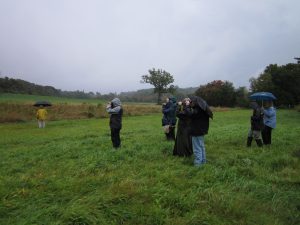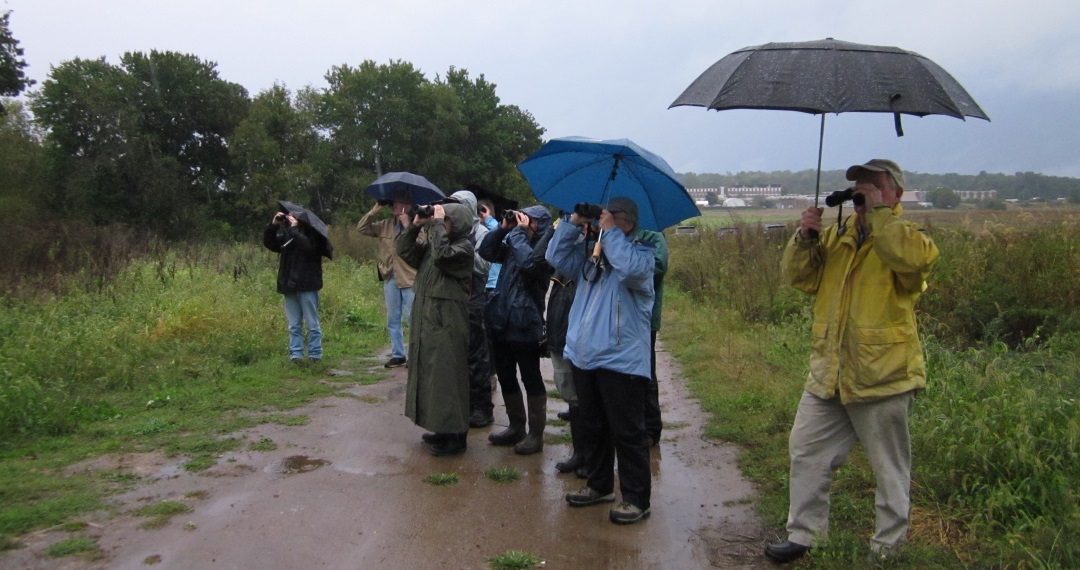Water Closet for October 13, 2017
It was raining the morning of a recent Ipswich River Water Association’s bird walk. [pullquote]” Several coopers hawks, a sharp-shinned hawk, a Merlin, a peregrine falcon, two harriers, a red tailed hawk, and a possible goshawk were seen”[/pullquote]Those looking forward to the Suzanne Sullivan1 led event stepped out before eight into a cold rain. The Old Closeteer, who wore a rain jacket and carried an umbrella, decided to drive to the beautiful State-owned fields on the Middleton-Danvers line just east of the Ipswich River2 where the event was to start. He expected to return in a few minutes because no one would be meeting on such a day. He drove by the house of a friend who had planned to go but her car was still in the yard. It looked like she, who helped organize the bird walk, wasn’t going. He soon crossed the river and turned southeast into the lovely open land along Gregory and Dayton streets. The meeting place on the edge of the community gardens came into view and there to his surprise were eight cars.
Suzanne in rain gear with large camera in a plastic bag stood smiling in a little group similarly dressed, half also under umbrellas. The Closeteer immediately knew this was no meeting to discuss cancellation due to weather. He, a non-serious birder since boyhood mid-last century, hadn’t realized the spunkiness and dedication of true birders. He should have; he’d heard about them. Judy Schneider, the friend whose car he’d passed, soon arrived with her daughter Rachel and the group now complete was greeted and briefed on how to behave. “Move slowly, no sudden moves, be quiet,” Suzanne instructed the several obvious veteran birders and us rookies who were silently shivering and wondering how long the gathering would last in the still cold rain. Staying close so they could hear one another, the ten or so participants moved very slowly after their leader between the wet gardens, corn fields and a couple of heavily vegetated patches of illegal 20th century dumping from the Danvers State Hospital now over grown with trees and bushes. Less than a century ago patients had worked the fields the birders now walked. When visiting this area, almost a mile square of bottom land and surrounding foothills devoted to agriculture, the Closeteer imagines ghosts of long suffering patients now at rest. Their bodies were interred in two graveyards nearby. Spirits finally free they may walk the lovely fields down to the river or up to the summits of the nearby drumlins.

Members and friends of the Ipswich River Watershed Association look for birds while standing ankle deep in wet grass on the lovely fields below Hathorne Hill (background right) where Danvers State Hospital patients once worked. – Rachel Schneider photo
It soon became apparent to the rookies that they were with serious people having a good time as they scarred up small birds also silent in the rain. No “singing in the rain” as Gene Kelly would have them and us do. The birders in happy tones murmured quietly to one another about the location of birds sighted and bird characteristics observed. “Indigo bunting to right of the left lower fork in that apple tree. Just moved to higher branch.” “Yes indigo; Cool!” Another vet, speaking softly but excitedly, answered. We newcomers followed their pointing fingers and noted the directions that their binoculars pointed. At first the Closeteer’s saw little. Soon however, the cold was forgotten as the enthusiasm of his zealous companions caught him up; and some of the feelings of his teen years as an amateur birder, usually alone, returned. After an hour with these patient companions, so obviously content and seemingly ready to go all day, he got in the mood and learned to use his too long neglected binoculars properly with one hand, while holding an umbrella with the other. Accustomed to hiking quickly in the woods and fields he sees relatively little detail. This group, moving at a snail’s pace and pausing at each of many sightings, traveled less than a quarter mile in two hours as they discussed bird features. The Closeteer had always thought true birders very competitive. These showed not the slightest disappointment when wrong about identification. There were discussions and then agreement or friendly disagreement. When we, not-even-novices-yet, asked questions, the pros, especially Suzanne, answered patiently and well. She would remember our questions a half hour later and add to her answers. Soon we newcomers wanted to see more. We finally dared to point out a few things on our own. Rookie Rachel Schneider got us all laughing when jokingly she said, “Those are Canada geese,” when a couple were heard passing over.
The highlights of the morning were the many hawk sightings. Several coopers hawks, a sharp-shinned hawk, a Merlin, a peregrine falcon (“duck hawk”), two harriers (“marsh hawks”)3, a red tailed hawk, and a possible goshawk were seen. Even the pros seemed more excited upon seeing the larger birds, the predators. And speaking of predators the group long watched a coyote a couple hundred yards away hunting small animals in a neighboring hayfield. The climax of the birding day was when a spread out flight of Canada geese, flying low, came over us from the north en route to the stubble in recently harvested Richardson fields of cow-corn. There may have been 200 in a dozen little characteristic V formations making a great racket; over the fields they broke formation into many smaller groups and circled round and round checking out the ground before they finally landed to look for corn ears the harvest had left behind.

“What a glorious feeling, I’m happy again. Just birdin’, and birding in the rain.” – Rachel Schneider photo
Finally after two and one half hours the group broke up, the pros seeming reluctant to leave. The old Closeteer vowed to return with a friend now that he had learned to walk slowly and use his binoculars again. True birders aren’t crazy. Birds are beautiful and interesting as all those with feeders know. We share DNA with them. Many species are now thought to be endangered. Habitats like those walked, where fields, woods, and water together are found will help them survive. “North Andover Judy” a avid birder in our group had seen a once common bobolink in the diverse community garden field a few days before.
1 Suzanne Sullivan from Reading, longtime member of the Ipswich River Watershed Association, has long been a champion protecting our river.
2 The almost 600 acres of land in this geologically unusual basin below the drumlins Bare Hill to the north and Hathorne Hill to the east, east of the Ipswich River has been in agriculture use for four centuries and perhaps 3000 thousand years before that under the Indians. Much is a low basin with a manmade east-west swale but without a stream that flows to the river. Much of it is now being cultivated by Richardsons’ Farm. Four or so gently south sloping acres of good soil are devoted to lush community gardens. These are surrounded by hay fields and corn. Visit and walk around these fields and see what much of New England was like before the farms went out and the trees returned last century. The land and nearby river has become a favorite place for birders and hikers.
3 The names in quotes were the names common in the Old Closeteer’s boyhood. He bemoaned the loss of old names for new politically correct ones, such as, “oldsquaw” becoming “long tailed duck.” Leader Suzanne strongly disagreed and soon straightened him out. He’ll now use more descriptive “long tailed duck” when in company. Oldsquaws translated means gossipy old women. Long tail ducks in groups often melodiously chatter. Was “oldsquaw” the Indian name for this small duck or did the English colonists come up with it? By the way it is the male oldsquaw that makes most of the noise.
___________________________________________________________
WATER RESOURCE AND CONSERVATION INFORMATION
FOR MIDDLETON, BOXFORD AND TOPSFIELD
| Precipitation Data* for Month of: | July | Aug | Sept | Oct | |
| 30 Year Normal (1981 – 2010) Inches | 3.89 | 3.37 | 3.77 | 4.40 | |
| 2017 Central Watershed Actual | 3.43 | 1.22 | 3.2 | 0 as of Oct 5 | |
Ipswich R. Flow Rate (S. Middleton USGS Gage) in Cubic Feet/ Second (CFS):
For Oct 5, 2017 Normal . . . 7.7 CFS Current Rate . . . 1.92 CFS
*Danvers Water Filtration Plant, Lake Street, Middleton is the source for actual precipitation data thru Aug.
—————————————————————–
** Middleton Stream Team is the source of actual precipitation data for Sept and Oct…
Normals data is from the National Climatic Data Center.
THE WATER CLOSET is provided by the Middleton Stream Team: www.middletonstreamteam.org or <MSTMiddletonMA@gmail.com>


arirang hello my website is arirang
Top88 hello my website is Top88
fairuz hello my website is fairuz
VNU LIC hello my website is VNU LIC
boy 138 hello my website is boy 138
dana88 hello my website is dana88
talibet hello my website is talibet
osstem hello my website is osstem
js混淆 hello my website is js混淆